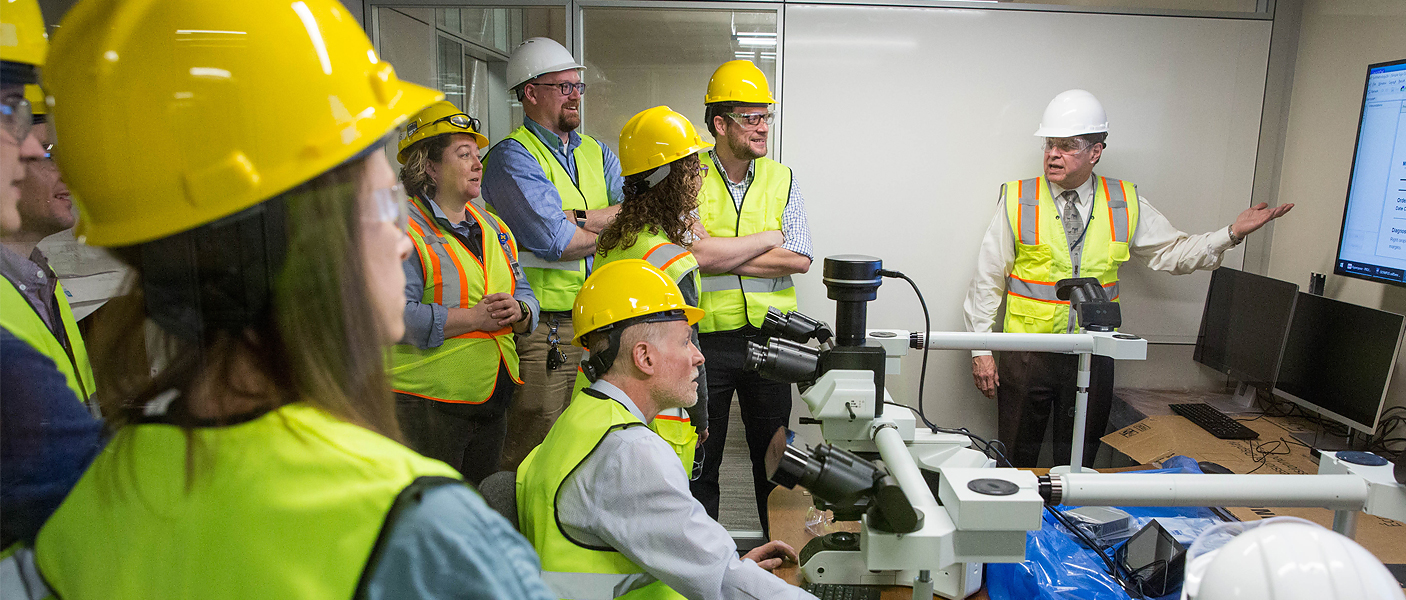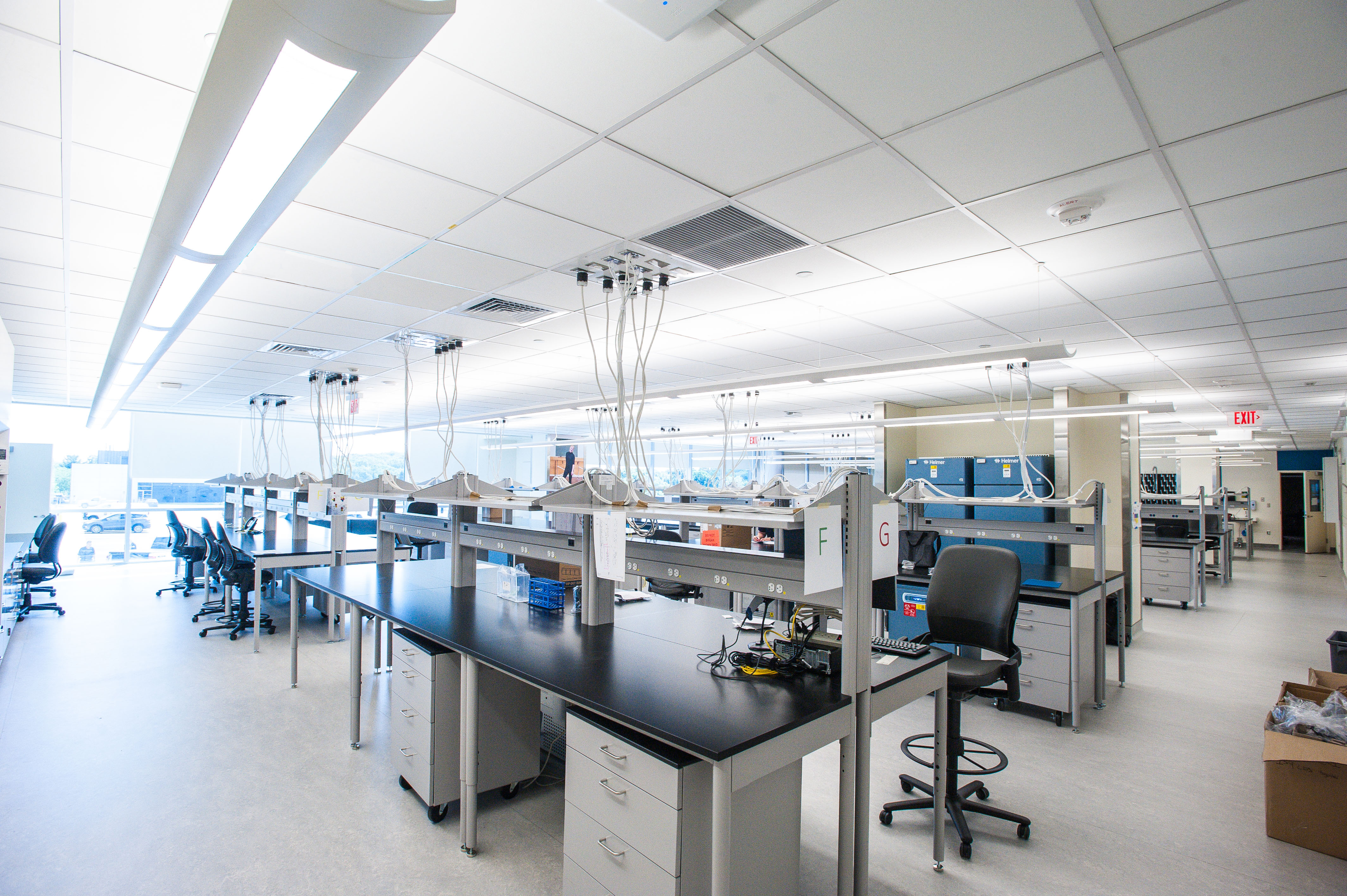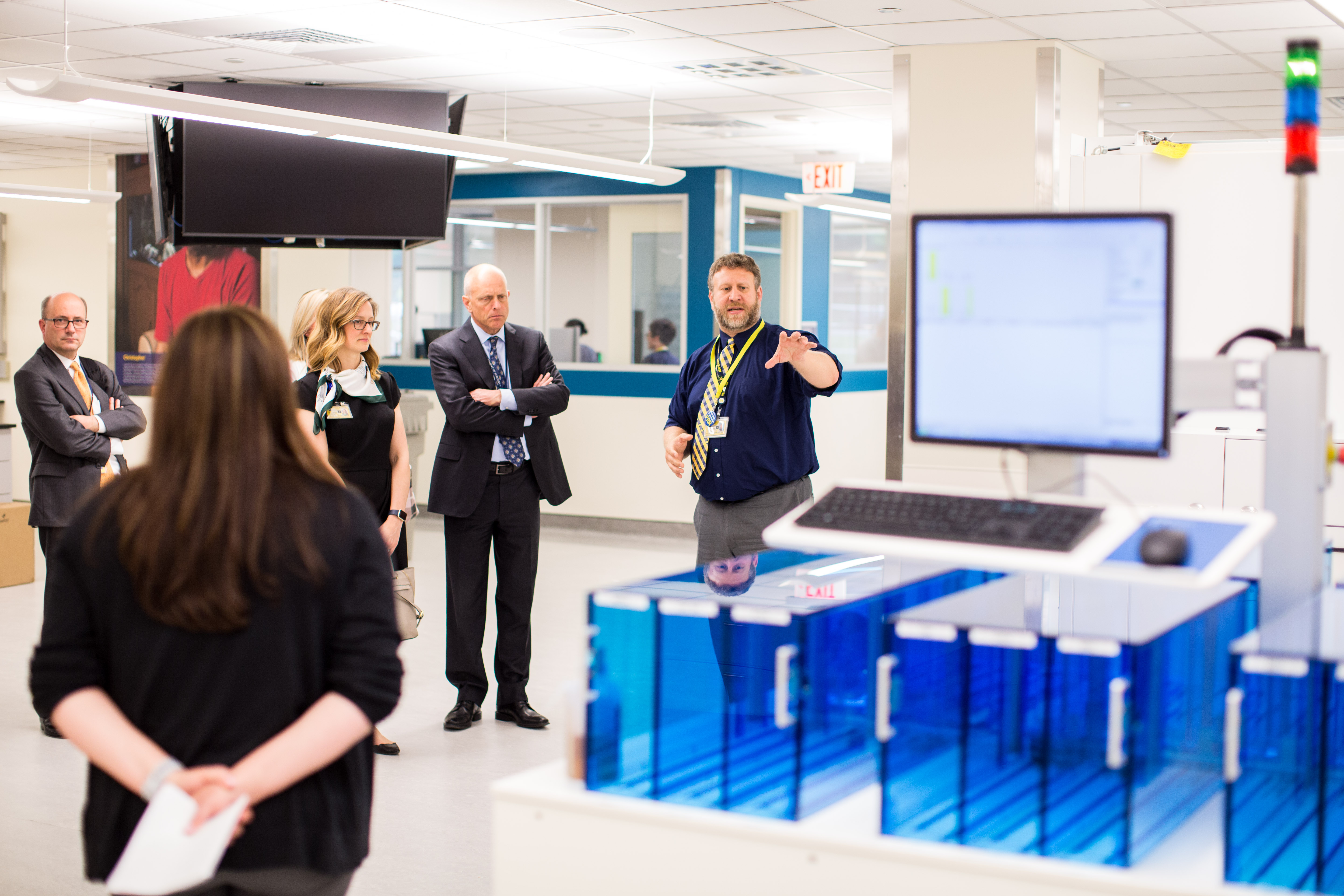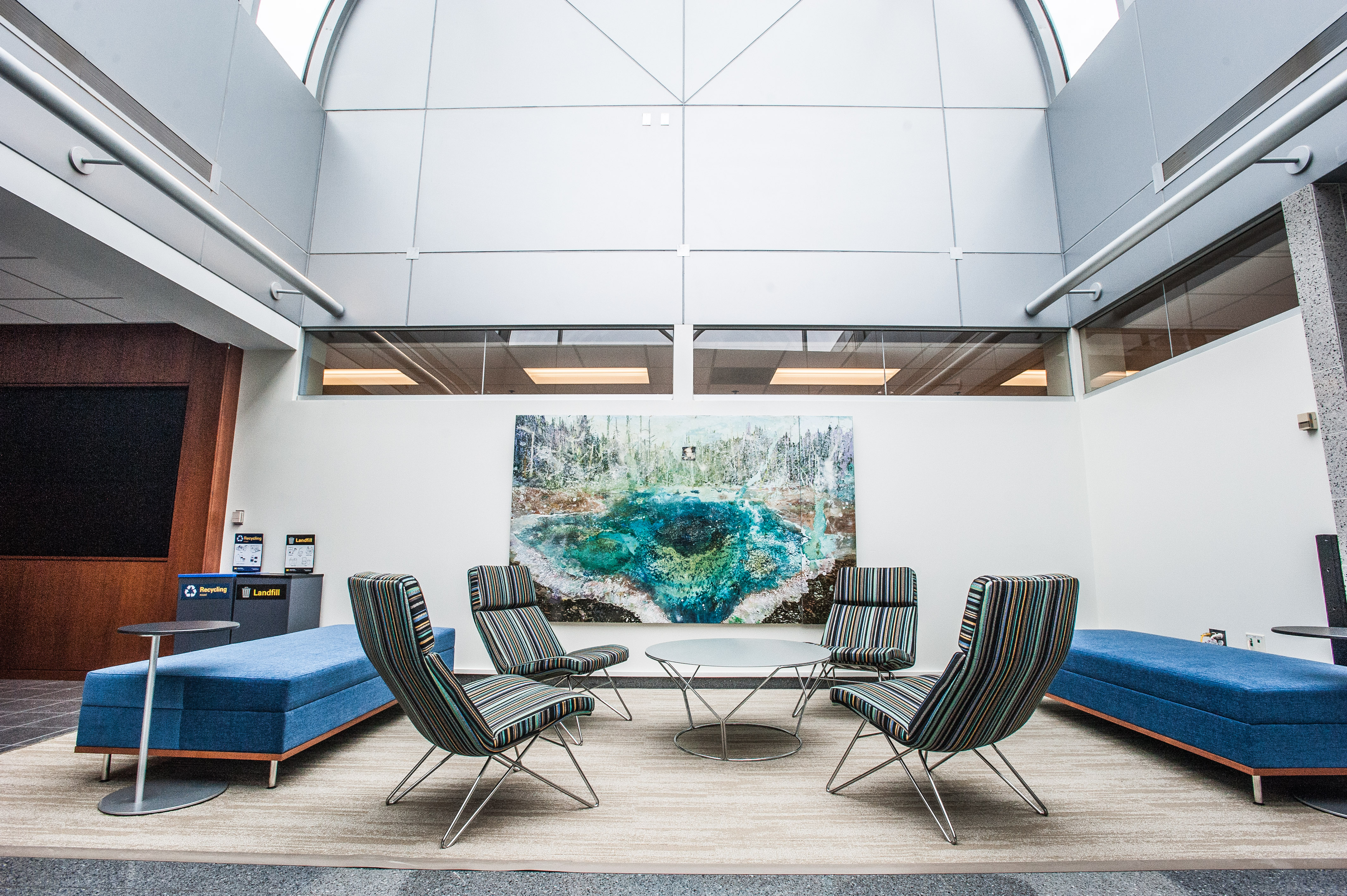

A flurry of last-minute preparations and problem solving consumed much of 2018 as the Pathology Renovation and Relocation team and strategic move captains prepared for the relocation of faculty, staff, trainees, and all the implements of a modern clinical pathology facility to the North Campus Research Complex. Throughout, the move captains ensured their laboratories, faculty neighborhood groupings, trainees, and administrative staff transitioned smoothly to Pathology’s new home 2.8 miles from the University Hospital. Over a period of approximately 3 months, these teams converged from locations across Ann Arbor into a consolidated 140,000 sq. feet state-of-the-art space designed for collaboration and to embrace the future. For the past year, the teams have been adjusting to the new space, adapting to new workflows, and taking advantage of the opportunities presented.
FIRST IMPRESSIONS
 The first thing many noticed about the new space is the natural light! Instead of being in basements or in crowded, internal laboratories without any windows, the laboratories have floor-to-ceiling walls of windows looking out at the park-like setting of the North Campus Research Complex. The space is bright and inviting. The laboratory bench space is designed to be movable, so it can be easily reconfigured as future technologies require new workflows. The labs are equipped with many familiar pieces of equipment, but also many newly-acquired pieces to enhance the capacity of the labs. Each laboratory was carefully planned using Lean Facility Design for optimal workflows and to encourage mentor/trainee interactions and teaching. In addition, the nerve centers for each lab are housed within the laboratories with clear line-of-sight between managers and the bench staff.
The first thing many noticed about the new space is the natural light! Instead of being in basements or in crowded, internal laboratories without any windows, the laboratories have floor-to-ceiling walls of windows looking out at the park-like setting of the North Campus Research Complex. The space is bright and inviting. The laboratory bench space is designed to be movable, so it can be easily reconfigured as future technologies require new workflows. The labs are equipped with many familiar pieces of equipment, but also many newly-acquired pieces to enhance the capacity of the labs. Each laboratory was carefully planned using Lean Facility Design for optimal workflows and to encourage mentor/trainee interactions and teaching. In addition, the nerve centers for each lab are housed within the laboratories with clear line-of-sight between managers and the bench staff.
Larger-than-life patient stories posted on walls in both laboratories and hallways remind all that excellent patient care is the focus of our work. Hallways and common spaces are enhanced with locally-created artwork. Conference rooms with glass walls line the exterior walls across from glass-walled offices, ensuring both offices and conference rooms are cheerfully lit. While not all offices are along this corridor, the majority are just steps away from natural light. Small offices make room for many common areas, conference rooms, and other work spaces to encourage collaboration among faculty and to enhance communication between faculty, trainees, and staff. A favorite common area to all is Central Park, complete with a long plank-wood dining table in a kitchenette adjoining high tables, soft seating, and a long fireplace, with natural greenery and artwork. This warm and welcoming space is shared by all of Pathology and is the heart of the new facility.
ADJUSTING TO CHANGE
 The beautiful facilities provide the framework for success, yet they also require staff to adapt to the new environments. In the molecular pathology division, six laboratories that were scattered across Ann Arbor, each with separate cultures and norms, are now co-located in contiguous molecular laboratories. The new space provides an opportunity to have back-up equipment available in case of equipment failure. “The move is a win for the Molecular Division,” stated Dr. Thomas Giordano, Director of the Division of Molecular Pathology. “We were in Traverwood (an off-site facility),” stated Dr. Lina Shao, Director of Cytogenetics, “which was isolating. Now we are at the NCRC and are more fully integrated. We feel like we are a real part of the Department. The move had a positive impact for our lab.”
The beautiful facilities provide the framework for success, yet they also require staff to adapt to the new environments. In the molecular pathology division, six laboratories that were scattered across Ann Arbor, each with separate cultures and norms, are now co-located in contiguous molecular laboratories. The new space provides an opportunity to have back-up equipment available in case of equipment failure. “The move is a win for the Molecular Division,” stated Dr. Thomas Giordano, Director of the Division of Molecular Pathology. “We were in Traverwood (an off-site facility),” stated Dr. Lina Shao, Director of Cytogenetics, “which was isolating. Now we are at the NCRC and are more fully integrated. We feel like we are a real part of the Department. The move had a positive impact for our lab.”
The anatomic pathology laboratories now require patient specimens be transported between the UH and NCRC. This created an entirely new workflow, requiring additional staff, and a complex specimen tracking process. Pathology Informatics and the Division of Quality and Healthcare Improvement elegantly solved the tracking challenges with PathTrack™, which was featured in last year’s edition of Inside Pathology Magazine. “When we first moved in, PathTrack wasn’t able to keep up with the increased demand, so the application did not work efficiently as the number of users increased,” explained Dr. Ul Balis, Director of Pathology Informatics. “So the team stepped up, not only solving that architectural problem, but also extending certain features. Now we are deploying PathTrack to multiple clinical sites at the University Hospital and the Taubman clinic.” PathTrack has attracted significant attention from other organizations as well.
Administrative staff are located in close proximity to the faculty providing more opportunities for interaction and discussion, improved communication and engagement.
 With the more open and collaborative environments, faculty and staff also faced adjustments. Administrative staff are located in close proximity to the faculty providing more opportunities for interaction and discussion, improved communication and engagement. Faculty are now part of multi-disciplinary neighborhoods, which has led to opportunities to reach out to neighbors for quick case conferences or for impromptu meetings at multi-headed microscopes. Residents and fellows are located in bright, modern space at the heart of the laboratories, adjacent to the sign-out areas and near the faculty suite. Robust educational experiences were built into the layout of the laboratories and sign out areas. While the overall environment for our trainees significantly improved, the relocation also meant that the residents and fellows needed to commute between the hospital and the laboratories for rotations in the stat labs and to attend some seminars and multi-disciplinary conferences. Digital signage prominently displayed throughout the space includes both inbound and outbound bus arrival times to assist in this commute. Pathology Informatics is located just down the hall from the faculty suite and administrative offices, which enhances service delivery and access for technical support. “Having MLabs right here with us makes it much easier to reach out to the outreach team themselves,” said Dr. David McClintock, Associate Professor of Pathology Informatics and Assistant CIO for Michigan Medicine. “We are close to the billing team and both AP and CP operations as well as Administration,” added Kathy Davis, Administrative Director of Pathology Informatics.
With the more open and collaborative environments, faculty and staff also faced adjustments. Administrative staff are located in close proximity to the faculty providing more opportunities for interaction and discussion, improved communication and engagement. Faculty are now part of multi-disciplinary neighborhoods, which has led to opportunities to reach out to neighbors for quick case conferences or for impromptu meetings at multi-headed microscopes. Residents and fellows are located in bright, modern space at the heart of the laboratories, adjacent to the sign-out areas and near the faculty suite. Robust educational experiences were built into the layout of the laboratories and sign out areas. While the overall environment for our trainees significantly improved, the relocation also meant that the residents and fellows needed to commute between the hospital and the laboratories for rotations in the stat labs and to attend some seminars and multi-disciplinary conferences. Digital signage prominently displayed throughout the space includes both inbound and outbound bus arrival times to assist in this commute. Pathology Informatics is located just down the hall from the faculty suite and administrative offices, which enhances service delivery and access for technical support. “Having MLabs right here with us makes it much easier to reach out to the outreach team themselves,” said Dr. David McClintock, Associate Professor of Pathology Informatics and Assistant CIO for Michigan Medicine. “We are close to the billing team and both AP and CP operations as well as Administration,” added Kathy Davis, Administrative Director of Pathology Informatics.
BUILDING ON SUCCESS
Now that we have been at the NCRC for one year, people are settling into their new space and routines and are beginning to look to how they can take full advantage of our facilities.
“The molecular laboratories have come together and the changes we have seen with the molecular lab and our work are significant,” stated Dr. Shao. “In cytogenetics, we were manually extracting DNA. The molecular lab, however, uses robots to do DNA extractions. Now we are able to use their resources. We validated DNA extraction by robots for both blood and bone marrow. That saves us a lot of work.” In addition, the new microarray laboratory layout allowed for other efficiencies. Rather than being in rooms on opposite ends of the hallway, the pre-PCR and post-PCR rooms are now in adjacent air-pressure-controlled environments to reduce contamination possibilities. Technologists simply move specimens a few steps rather than boxing them up and walking down the hall. Use of a new Thermotron eliminated the need for a cold room to process specimens, reducing exposure to caustic chemicals. Specimens are now safely processed in the contained, vented, box-like Thermotron.
“Now that we have the move done,” stated Dr. McClintock, “we are starting to work on new projects. We have some very good potential pathology solutions in the pipeline that this lab has enabled us to do. We have new, dedicated space for development for the future.” “This new space allowed us to be more productive with the precision medicine project,” agreed Dr. Balis. “One example of this is the whole slide-viewer technology developed by Dr. Jerome Chang, which has become the national standard now for the NCI/NIDDK for viewing whole slide images. That was a huge win!”
As Pathology continues to integrate within the new space and adjust to new possibilities, a new project has been initiated – the renovation of the STAT and core laboratories at the University Hospital. This four-year project will continue to both challenge us and help us improve patient care as we look to the future. The PRR team learned a great deal from the relocation of our laboratories to the NCRC. Many of these lessons learned are being applied to the University Hospital Project. We are looking forward to the possibilities for enhanced patient care that will emerge as a result of these renovations.
 ON THE COVER
ON THE COVER
Breast team reviewing a patient's slide. (From left to right) Ghassan Allo, Fellow; Laura Walters, Clinical Lecturer; Celina Kleer, Professor. See Article 2014Department Chair |

newsletter
INSIDE PATHOLOGYAbout Our NewsletterInside Pathology is an newsletter published by the Chairman's Office to bring news and updates from inside the department's research and to become familiar with those leading it. It is our hope that those who read it will enjoy hearing about those new and familiar, and perhaps help in furthering our research. CONTENTS
|
 ON THE COVER
ON THE COVER
Autopsy Technician draws blood while working in the Wayne County morgue. See Article 2016Department Chair |

newsletter
INSIDE PATHOLOGYAbout Our NewsletterInside Pathology is an newsletter published by the Chairman's Office to bring news and updates from inside the department's research and to become familiar with those leading it. It is our hope that those who read it will enjoy hearing about those new and familiar, and perhaps help in furthering our research. CONTENTS
|
 ON THE COVER
ON THE COVER
Dr. Sriram Venneti, MD, PhD and Postdoctoral Fellow, Chan Chung, PhD investigate pediatric brain cancer. See Article 2017Department Chair |

newsletter
INSIDE PATHOLOGYAbout Our NewsletterInside Pathology is an newsletter published by the Chairman's Office to bring news and updates from inside the department's research and to become familiar with those leading it. It is our hope that those who read it will enjoy hearing about those new and familiar, and perhaps help in furthering our research. CONTENTS
|
 ON THE COVER
ON THE COVER
Director of the Neuropathology Fellowship, Dr. Sandra Camelo-Piragua serves on the Patient and Family Advisory Council. 2018Department Chair |

newsletter
INSIDE PATHOLOGYAbout Our NewsletterInside Pathology is an newsletter published by the Chairman's Office to bring news and updates from inside the department's research and to become familiar with those leading it. It is our hope that those who read it will enjoy hearing about those new and familiar, and perhaps help in furthering our research. CONTENTS
|
 ON THE COVER
ON THE COVER
Residents Ashley Bradt (left) and William Perry work at a multi-headed scope in our new facility. 2019Department Chair |

newsletter
INSIDE PATHOLOGYAbout Our NewsletterInside Pathology is an newsletter published by the Chairman's Office to bring news and updates from inside the department's research and to become familiar with those leading it. It is our hope that those who read it will enjoy hearing about those new and familiar, and perhaps help in furthering our research. CONTENTS
|
 ON THE COVER
ON THE COVER
Dr. Kristine Konopka (right) instructing residents while using a multi-headed microscope. 2020Department Chair |

newsletter
INSIDE PATHOLOGYAbout Our NewsletterInside Pathology is an newsletter published by the Chairman's Office to bring news and updates from inside the department's research and to become familiar with those leading it. It is our hope that those who read it will enjoy hearing about those new and familiar, and perhaps help in furthering our research. CONTENTS
|
 ON THE COVER
ON THE COVER
Patient specimens poised for COVID-19 PCR testing. 2021Department Chair |

newsletter
INSIDE PATHOLOGYAbout Our NewsletterInside Pathology is an newsletter published by the Chairman's Office to bring news and updates from inside the department's research and to become familiar with those leading it. It is our hope that those who read it will enjoy hearing about those new and familiar, and perhaps help in furthering our research. CONTENTS
|
 ON THE COVER
ON THE COVER
Dr. Pantanowitz demonstrates using machine learning in analyzing slides. 2022Department Chair |

newsletter
INSIDE PATHOLOGYAbout Our NewsletterInside Pathology is an newsletter published by the Chairman's Office to bring news and updates from inside the department's research and to become familiar with those leading it. It is our hope that those who read it will enjoy hearing about those new and familiar, and perhaps help in furthering our research. CONTENTS
|
 ON THE COVER
ON THE COVER
(Left to Right) Drs. Angela Wu, Laura Lamps, and Maria Westerhoff. 2023Department Chair |

newsletter
INSIDE PATHOLOGYAbout Our NewsletterInside Pathology is an newsletter published by the Chairman's Office to bring news and updates from inside the department's research and to become familiar with those leading it. It is our hope that those who read it will enjoy hearing about those new and familiar, and perhaps help in furthering our research. CONTENTS
|
 ON THE COVER
ON THE COVER
Illustration representing the various machines and processing used within our labs. 2024Department Chair |

newsletter
INSIDE PATHOLOGYAbout Our NewsletterInside Pathology is an newsletter published by the Chairman's Office to bring news and updates from inside the department's research and to become familiar with those leading it. It is our hope that those who read it will enjoy hearing about those new and familiar, and perhaps help in furthering our research. CONTENTS
|
 ON THE COVER
ON THE COVER
Rendering of the D. Dan and Betty Khn Health Care Pavilion. Credit: HOK 2025Department Chair |

newsletter
INSIDE PATHOLOGYAbout Our NewsletterInside Pathology is an newsletter published by the Chairman's Office to bring news and updates from inside the department's research and to become familiar with those leading it. It is our hope that those who read it will enjoy hearing about those new and familiar, and perhaps help in furthering our research. CONTENTS
|

MLabs, established in 1985, functions as a portal to provide pathologists, hospitals. and other reference laboratories access to the faculty, staff and laboratories of the University of Michigan Health System’s Department of Pathology. MLabs is a recognized leader for advanced molecular diagnostic testing, helpful consultants and exceptional customer service.